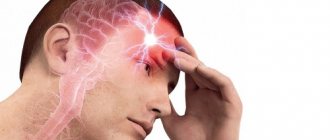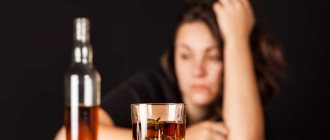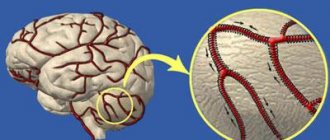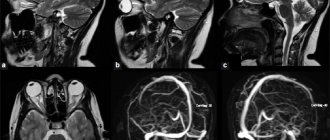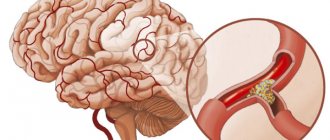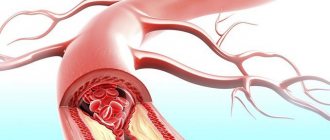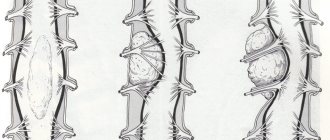Vegetative-vascular dystonia is a diverse and multifaceted disease that affects the entire body and some of its functions. There is a subtype of VSD that negatively affects the blood vessels of the brain, which leads to tangible consequences for the whole organism.
How are the VSD and cerebral vessels interconnected, what symptoms can be used to understand that they need to be strengthened, and how, in fact, to do this?
General recommendations
To understand what happens to blood vessels during VSD, you must first understand how the autonomic system works. It is the part of the nervous system responsible for heart rate, hormone production, blood pressure, respiratory system, and feelings of satiety or hunger. When the system malfunctions, the vessels are the first to suffer. Their tone decreases or, on the contrary, becomes excessive, which leads to pathological changes in the structure.
To strengthen blood vessels during VSD, you must first adjust your daily routine, your diet, reduce physical stress on the body (but go for a walk every day) and get rid of bad habits (smoking and regular drinking).
To regulate vascular tone, magnetic therapy, darsonvalization, and electrophoresis should be done. The specifics of the procedures and their systematicity should be selected by the attending physician.
✅strong blood vessels – a guarantee of good health
Do you often feel pressure in your chest or headaches? Are you worried about mood swings, react to weather changes, but doctors say there is no reason for this? In this case, there is still a reason, and it is called vegetative-vascular dystonia, or VSD.
The unpleasant symptoms of this disorder are caused by an imbalance between the components of the nervous system responsible for the “plant” functions of the body:
- breath;
- blood circulation and heart function;
- digestion.
There is an interaction between nerve fibers (nervous) and blood vessels. When the walls of blood vessels lose their elasticity, the autonomic innervation ceases to function normally, and the manifestations of VSD become brighter.
Strengthening the walls of brain vessels will help reduce the intensity and frequency of attacks.
Diets to strengthen blood vessels
The diet of patients with VSD is based on the principles of rational nutrition:
- providing the body with the necessary macro- and microelements: you need to include in the diet foods that contain the physiological norm of proteins, fats and carbohydrates;
- the presence in the menu of products that improve blood circulation and stabilize blood pressure;
- regular consumption of water (about 2 liters) to stabilize the water-salt balance.
A balanced diet is the answer to the question of how to increase vascular tone during VSD.
With the hypertensive type of vegetative-vascular dystonia, it is necessary to limit the consumption of salt and products containing it:
The diet should be enriched with potassium and magnesium, since potassium promotes the excretion of water and sodium, and magnesium has vasodilating properties.
It is necessary to limit the consumption of fatty and fried foods, carbonated drinks and alcohol.
With VSD of the hypotonic type, the diet should contain various salted and fermented foods that bind water in the body and increase blood pressure.
You also need to include in the menu:
- butter;
- fatty meat and fish;
- cheeses;
- smoked meats
You should not give up drinking strong coffee, tea, chocolate and tonic drinks.
Prevention of violations
Prevention plays a key role in the normal functioning of the body and the functioning of blood vessels. It is known that abnormalities in the nervous system contribute to the development of cerebral vascular pathologies. Difficulties in work or family, depression or death of loved ones lead to complete destruction of the nervous system and blood vessels.
The presence of bad habits such as smoking and addiction to alcohol leads to the development of pathologies. Thus, alcohol, after penetrating into the blood, noticeably thickens it, and the alcohol contained in the drink destroys the walls of blood vessels.
As for smoking, it is a colossal stress for the body and increases the load on blood vessels. Such an impact leads to their narrowing and then expansion.
VSD is often caused by poor nutrition, accompanied by excessive consumption of fatty, fried, salty and spicy foods. All such dishes lead to the deposition of cholesterol on the walls of blood vessels.
In connection with the above fact, a person should exercise regularly, because a sedentary lifestyle contributes to the formation of stagnation in the blood. And this affects the weakening of blood vessels and their filling with fat.
As a result, it turns out that to prevent problems with blood vessels, it is necessary to control emotions and avoid stress, give up bad habits and start playing sports.
Source: serdce.hvatit-bolet.ru
Folk remedies
There are many folk methods that are used to strengthen blood vessels:
- Mix chamomile, St. John's wort, immortelle, birch buds and yarrow in equal proportions. For the full course of treatment you will need 1 glass of dry raw materials of each medicinal plant. 1 tbsp. collection, pour 500 g of boiling water and leave for 2-3 hours. After this, the infusion is filtered, a little honey is added and taken 2 times a day - in the morning on an empty stomach and in the evening before bed. The course of treatment must be completed every 4 years. This product cleanses blood vessels and restores their elasticity.
- To strengthen blood vessels, you can take medicine made from garlic and cranberries. Take cranberries and garlic in equal proportions, grind using a meat grinder or blender and let it brew for 3 days. After this, the mixture must be thoroughly squeezed out. Add a little honey to the resulting juice (to improve taste) and take 1 tbsp before meals. 2 times a day.
- Take 5 walnut kernels, chop, add 1 tbsp. honey and leave for 1 day. This medicine should be taken 4 times a day, 1 tbsp. The course of treatment is 30 days. This cleaning of vessels is carried out 2 times a year.
Other recommendations not related to the use of medications:
- play sports: walking, running, swimming, but do not overdo it with the choice of load volume;
- take a contrast shower once a day and visit the bathhouse as often as possible;
- place a massage mat near the bed to improve blood circulation in the legs;
- learn to alternate work and rest.
Herbal preparations for the treatment of VSD
Collection for men:
- rose hips fruits - 4 parts;
- licorice roots - 4 parts;
- St. John's wort herb - 3 parts;
- valerian roots - 3 parts;
- mistletoe grass - 2 parts;
- roots of Leuzea, Rhodiola and Angelica - 2 parts each.
Collection for women:
- angelica roots and viburnum fruits - 3 parts each;
- roots of dandelion, licorice, Rhodiola rosea, Leuzea - 2 parts each;
- nettle leaves - 2 parts;
- rose hips - 2 parts;
- wormwood and knotweed - 2 parts each.
Preparation:
- Grind herbs, fruits and roots in a coffee grinder.
- We take two tablespoons of the herbal powder that we ground and pour it into a thermos with 0.5 liters of boiling water.
- Let it sit overnight.
- In the morning, the resulting infusion can be drunk.
- Application for treatment:
- The dosage is one third of a glass, three times a day.
- Treatment of VSD with herbs should be carried out over a course of 6–8 weeks.
Treatment of vegetative-vascular dystonia with folk remedies depends on the symptoms that predominate in the clinic of this disease. For example, hawthorn is better suited for the hypertonic version of VSD, and barberry for the hypotonic version. In mixed forms, various combinations of herbs (hops, fennel, etc.) are widely used.
As for food products that are useful for VSD, the following must be present in the diet:
- fish and seafood;
- carrots;
- cereals;
- fruit;
- dairy products;
- fresh herbs;
- nuts.
These products contain substances that have a beneficial effect on the functioning of the autonomic nervous system. It is important to remember that excessive consumption of any one type of food can lead to gastrointestinal dysfunction. Therefore, it is important that the ingredients are harmoniously balanced. Only in this case can you count on the beneficial effects of these products.
Medicines and vitamins
To improve the condition of blood vessels, doctors recommend taking the following medications and vitamins:
- ascorbic acid (vitamin C) - strengthens capillaries;
- rutin (vitamin P) - reduces fragility;
- fat-soluble vitamin E - increases strength and improves the general condition of the body;
- Detralex - stabilizes the condition of capillary walls;
- statins (Atorvastatin) - partially flush cholesterol from artery walls and reduce atherosclerotic plaques;
- metabolic drugs (Piracetam, Cerebrolysin, Corvitin) - improve blood flow in the vessels of the brain;
- antihypertensive drugs (Bisoprolol, Lisinopril) - reduce blood pressure, indirectly strengthening the arteries.
- antithrombotic (acetylsalicylic acid) - prevent the formation of blood clots in the arteries.
These drugs significantly improve the condition of blood vessels. They are used both for prevention and in complex therapy.
Dear readers! We strongly recommend that you consult a doctor before taking medications or self-medicating. There are contraindications.
Vegetative-vascular dystonia is a diverse and multifaceted disease that affects the entire body and some of its functions. There is a subtype of VSD that negatively affects the blood vessels of the brain, which leads to tangible consequences for the whole organism.
How are the VSD and cerebral vessels interconnected, what symptoms can be used to understand that they need to be strengthened, and how, in fact, to do this?
Products
| Olive oil | Promotes the dissolution of blood clots and other cholesterol plaques, improves the walls of blood vessels, making them elastic. |
| Fish | It contains a large amount of polyunsaturated fatty acids, which help lower blood pressure, thereby preventing the development of heart pathologies. Red fish is healthier for the body. |
| Garlic | Thins the blood and stimulates blood vessels. It is recommended to consume it not in its pure form, but in a crushed state. |
| New potatoes | The potassium content leads to a positive effect on the functioning of the cardiovascular system. |
| Avocado | A healthy fruit for lowering cholesterol. Avocado pulp contains beta-carotene and lycopene, which have a good effect on heart function. |
| Black chocolate | This delicacy can lower blood pressure, increase blood flow to the brain and other vital organs, and simply improves the production of endorphins, which significantly improves mood. |
| Pumpkin | A useful vegetable for strengthening the walls of blood vessels due to its high content of vitamin C, potassium, and beta-carotene. |
| Dried apricots | This dried fruit contains a lot of potassium, which is recommended for use to prevent myocardial infarction. |
| Grape | It is a healthy fruit because it contains a large amount of vitamins that have a positive effect on the functioning of the heart and blood vessels. |
| Nuts | This delicacy contains carotene, unsaturated fatty acids, vitamin B1 and minerals - all components that have a beneficial effect on strengthening the walls of blood vessels. |
What is dystonia?
The concept of dystonia itself implies problems with the nervous system. The autonomic apparatus is divided into the sympathetic and parasympathetic systems. Depending on the needs of the body, they give opposing commands to the organs, for example, to constrict and dilate the pupil in the dark or influence the capacity of blood vessels.
When the autonomic system malfunctions due to stress, poor lifestyle, and weakness of the body, the body receives incorrect commands. The vessels are responsible for filling it with blood, which, in turn, saturates it with nutrients and removes metabolic products, creates stable pressure, controls the filling of cells with oxygen and the removal of carbon dioxide from them. To do this, the walls of blood vessels narrow when it is necessary to reduce blood flow or expand to increase it.
Symptoms of VSD
In order to recognize dystonia in time and understand how to strengthen the walls of brain vessels during VSD, you need to know the symptoms of the disease well. It is worth talking about this disease more often, since, according to doctors, dystonia occurs in one form or another in 40% of the population.
Symptoms of dystonia:
- Headache often and for a long time. The pain is not sharp, aching, suppressing mood,
- Tinnitus for no apparent reason,
- Unexpected dizziness up to loss of orientation,
- Frequent groundless panic, manifestation of spontaneous and causeless fears, constant anxiety and restlessness,
- The mood is constantly changing, the changes are sharp and contrasting,
- Irritability, impatience with others, constant nervousness, desire to fiddle with something in your hands, draw, pull or touch,
- Constant drowsiness even with normalized regular sleep, often want to sleep during the day,
- Occasionally a person feels like he is suffocating, there is not enough oxygen, but this feeling should not be acute,
- There is a trembling, similar to a nervous one,
- Bags under the eyes appear sharply, the face swells and swells.
The importance of a daily routine
Recommendations about a daily routine and sufficient time for sleep and rest seem banal, but without proper rest, no recovery is possible. The fact is that the mismatch in the work of different parts of the autonomic nervous system, which underlies headaches, cannot be controlled by willpower. Nature is wiser than us, and if a person does something to his own detriment, diseases begin that force him to return to a normal lifestyle.
There is nothing more harmful to your well-being than lack of sleep and constant stress. There is no doubt that in order to achieve something, you need to strain and sometimes overload yourself. But if there is no rest after overload, illness is guaranteed.
It is necessary to achieve a quality night's sleep. To do this, you definitely need darkness so that the hormone melatonin is released. If sleep does not come for a long time, it is better to take sleeping pills than to live the next day with a cast-iron head. The pharmacy chain has a lot of over-the-counter medications for deepening sleep.
Eliminating alcohol and smoking produces an amazing healing effect. True, for this sometimes you have to undergo a course of specialized treatment.
Who is at risk?
Vegetative-vascular dystonia, like any other disease in the body, does not arise out of the blue. Although it does not cause serious health problems, it significantly worsens a person’s quality of life. Here is a list of factors that put people at risk:
- Frequent stress, which greatly affects the nervous state and behavior of blood vessels in the brain,
- Troubles that keep a person under serious stress for a long time,
- Genetic predisposition – initially insufficiently elastic brain vessels,
- Focal infections in the brain and the body as a whole,
- Changes in hormonal levels - during menopause, dystonia is most likely,
- Skull injuries, brain damage,
- Poor lifestyle – frequent use of alcohol, tobacco, drugs and unhealthy food,
- Osteochondrosis of the cervical vertebrae, blocking blood access to the brain,
- Frequent excessive sports stress on the body,
- Exposure to radiation or chemical intoxication,
- Lack of sleep and climate change, the body’s reaction to it.
Causes
When a patient comes to a medical facility, the attending physician must first determine the cause of vascular dystonia. The development of dystonia can be triggered by the following factors:
- stressful life situation, for example, the death of a relative;
- constant troubles in the family and work can lead to prolonged psycho-emotional stress;
- genetic inheritance can provoke cerebral vascular dystonia;
- focal infections can cause complications, manifested in symptoms of cerebral vascular dystonia;
- During pregnancy, menopause, and puberty, a person’s hormonal levels change, which can result in dystonia;
- cranial injuries;
- smoking, addiction to alcoholic beverages, drugs;
- unhealthy food;
- osteochondrosis, in which the cervical vessels are compressed, resulting in impaired blood flow to the brain;
- heavy sports and physical activity;
- the effect of radiation;
- exposure to chemical intoxication;
- violation of the daily routine, constant lack of sleep;
- change in climatic conditions;
What are the ways to strengthen blood vessels?
Conventionally, methods of strengthening blood vessels for dystonia are divided into three parts. The first is medications, including tablets and ointments for local use. They are used for problems with cerebral vessels that arise as a result of serious diseases and disorders of the body, and not for VSD.
For example, such a drug is heparin or hormonal ointment. In case of VSD, their use is usually unjustified, especially frequent, since this problem can be solved in ways that are more friendly to the body. Sometimes they take mild painkillers to relieve obsessive headaches caused by VSD.
The second part is folk methods, decoctions and herbs that act slowly, easily and unobtrusively, improving the overall health of the body and brain. Within reasonable limits, this is useful for the treatment and prevention of VSD. To increase the effectiveness of treatment, there is a third part - physiotherapy, sufficient sports activities, proper nutrition and sleep patterns. All this will not only overcome cerebral vascular dystonia over time, but will also take your overall shape, mood and appearance to a qualitatively new level. Let's take it in order.
Methods for diagnosing the condition of arteries
Before examining the question of how to strengthen the cerebral vessels during VSD, it is necessary to conduct a full examination to identify the pathology and determine the treatment method.
Possible methods for studying blood vessels include:
| Angiography | The main type of study involves the introduction of a special contrast agent to obtain a corresponding X-ray image of the blood vessels of the brain. Using the image, you can determine the degree and duration of filling of the vessels with blood. |
| Electroencephalography | Allows you to determine pathological changes in the brain. The method determines the recording of electrical potentials in the brain. |
| CT scan | Detects brain damage, its location, extent and nature by analyzing computer data and x-rays. |
| Rheoencephalography (REG) | Records and evaluates electrical resistance of tissues. |
| MRI | Using brain imaging, it is possible to identify the presence and location, shape and distribution of existing lesions. |
Nutrition
To make it tastier, you should add fish to this, any fish except smoked. It should be excluded altogether, especially during periods of exacerbation. Literally a medicinal product - fatty fish with polyunsaturated fatty acids. These are red species and, if cheaper, regular mackerel. You should treat baked goods of any kind, as well as starchy products - potatoes, corn, etc. with caution, eat a little, only in the morning and after a hearty breakfast.
Meat is also relevant, but in small quantities. It is better to eat stewed or boiled beef and poultry. A rabbit is also possible. Very bad - fried pork, tasty, but not for vessels.
Vitamins and herbs
You can get them for VSD in the following ways:
- Grind prunes, lemons straight with skins, dried apricots and walnuts. Add 50 grams of vegetable oil, preferably cold-pressed, and the same amount of liquid honey. Eat a teaspoon after morning and evening meals.
- Jam and fresh berries of cranberries, rose hips, rowan berries, hawthorn, currants and cherries are a valuable source of nutrients. It's best to eat them straight with a spoon without any processing.
- For vegetative-vascular dystonia of the brain, it is worth drinking decoctions of red clover, cucumber, Japanese sophora, and it is good to use barberry - bark and leaves. Pour a tablespoon of dry raw material into 200 ml a glass of boiling water and leave.
A folk remedy for the prevention of VSD should be discussed with your doctor, especially if you have other diseases. For example, if you have diabetes, you should not use the first recipe - the blood glucose level may rise dangerously. An important condition is that decoctions and mixtures should be consumed in limited quantities!
To prevent problems with blood vessels and even during exacerbations of VSD, you should pay attention to sports. The best exercise is dancing, and it doesn’t matter whether it’s fast or slow, flexible or fun - such exercise is beneficial for the body. You can train the blood vessels of the whole body, including the brain, by simply bending the body in all four directions - this is a good idea for regular morning exercises.
When wondering how to train blood vessels with vegetative-vascular dystonia, it is worth paying attention to basic habits in the field of a healthy lifestyle. Of course, it is impossible to implement everything at once, but by gradually developing the necessary skill, you can get rid of VSD and other diseases of the body, brain and blood vessels.
Optimal physical activity
Vessels actively work when muscles are loaded. The volume and intensity of physical activity tolerated is different for everyone - one person is “energized” by a morning jog, while another finds it difficult to climb stairs.
It is impossible to do without physical activity completely - the body atrophies what does not work. Therefore, by trial and error, you need to choose a load that makes a person feel good. This could be an evening walk, a gym session, or a home gymnastics complex.
You may also be interested in material about how VSD is treated and what medications are used for therapy.
Author of the article: Psychiatrist, psychotherapist Larisa Vladimirovna Neboga
Content
- Headache in the back of the head
- Head and eyes hurt
- Headache and fever
- Headache and nausea
- Headache during pregnancy
- Headache in temples
- Headache and dizziness
- Headache while breastfeeding
- Headache MISCELLANEOUS
- Headaches with osteochondrosis
- Blood pressure and headaches
- What can cause a headache?
- Brain cyst
- Nursing mother with headache
- Brain treatment
- Painkillers for headaches
- Brain tumor
- Why does my head hurt?
- Strong headache
- Headache tablets
- Fever and headache
- The child has a headache
- Frequent headaches
- What to do if you have a headache
- Encephalopathy
Pressure change
Headaches are considered one of the main signs of vegetative-vascular dystonia. These painful sensations are pulsating, press and shoot, literally “tearing” the head.
VSD and headaches may also be accompanied by regularly changing pressure, resulting in:
- the venous bed expands;
- the feeling of pressure on the meninges increases;
- migraine intensity increases.
Knowing about such symptoms, there is nothing to be surprised if the doctor prescribes venotonics, since they improve the strength of the vascular walls, regulate the movement of blood flow, and help keep pressure under control.
The safety of these venotonic drugs is based on the plant origin of their main components.
Therapy carried out with their help can be quite long - sometimes up to a couple of months.
The range of drugs from the described group is quite wide. However, you should only use those remedies prescribed by a qualified doctor, otherwise, instead of coping with VSD, you risk aggravating your own condition and causing complications of the primary disease.
Clinical manifestations of the disease
Dystonia of the cerebral vessels of the brain does not have constant clinical signs that allow an accurate diagnosis. For this purpose, various additional laboratory and instrumental studies are used.
The most common complaints from patients are:
- Aching or stabbing pain in the heart area, which is most often associated with overwork or stress, drinking strong alcoholic drinks or weather changes;
- Cardialgia can last for hours, and in severe cases - for days, and it is not relieved by taking standard antianginal drugs - validol or nitroglycerin. When taking a cardiogram at this moment, there will be no deviations from the norm;
- Pain in the heart area most often goes away on its own with little physical activity or after taking sedatives - valerian, hawthorn;
- Pain in the cardiac region is often accompanied by feelings of anxiety, fear and even panic; in mild cases, patients’ mood decreases and they feel short of breath;
- A number of patients experience rapid breathing, but its completeness does not satisfy the patients - they want to breathe even deeper. It is difficult for the patient to stay in a room with closed windows, he experiences dizziness, anxiety and fear of suffocation;
- Some patients experience attacks of palpitations, seemingly increased pulsation in the heart area. After a nervous shock, in some patients, the pulsation of the vessels of the neck increases; it is sometimes so pronounced that it interferes with falling asleep or wakes the patient up in the middle of the night.
- A relatively slight increase or decrease in blood pressure with an increase or decrease in heart rate. These signs may be combined with pain in the heart, a feeling of lack of air, in addition, weakness, sweating, dizziness, ringing in the ears, cold hands and feet may appear.
- The difference in indicators during thermometry in the armpit on the right and left in combination with cold extremities.
The more pronounced each of the signs is and the more manifestations are present in the clinical picture, the more severe the disease.
Symptoms
For cerebral vascular dystonia, it is difficult to list all the symptoms, since there are many of them and they change. Dystonia of the brain is characterized by the following symptoms:
- frequent or prolonged headaches, a feeling of heaviness in the head;
- a patient with dystonia may suddenly and severely feel dizzy or experience tinnitus;
- a patient with dystonia may experience a state of panic, a feeling of fear and anxiety;
- a patient with dystonia complains of frequent mood swings, he becomes irritable and nervous;
- in the middle of the day you may suddenly want to sleep;
- at times, a patient with dystonia experiences a feeling of lack of air;
- a person may experience trembling in the eyelids, head, fingers;
- The patient complains of bags under the eyes and a swollen face in the morning.
But, as a rule, not only the vascular system of the head is affected, but also the vessels of the entire human body:
- pain in the heart in the absence of obvious pathologies in it, a feeling of cardiac arrest may occur;
- increased or, less commonly, slow heartbeat;
- feeling of coldness in the extremities;
- the patient suffers from sweating or begins to shiver;
- the patient reacts to weather changes;
- the person’s face turns pale and red;
- the patient may faint;
- a person’s blood pressure fluctuates from high to low;
- the patient complains of fatigue;
- women suffer from premenstrual syndrome;
- there is general weakness.
Symptoms from the gastrointestinal tract are as follows:
- stomach pain may occur;
- stool changes;
- the person may experience nausea.
In connection with different expressions of cerebral vascular dystonia, it is customary to define the following syndromes:
- The presence of tachycardia syndrome is mainly observed in elderly people. It is characterized by an increase in heart rate, ranging from 90 to 150 beats per minute.
- In arrhythmic syndrome, arrhythmia or myocardia is observed. Typically, patients have diseases such as hyperfunction of the thyroid gland, osteochondrosis, and various diseases of the gallbladder.
- Cardiac syndrome is characterized by patient complaints of stabbing or aching pain in the heart, which occurs periodically in any condition of the person.
- The occurrence of bradycardic syndrome is a rather rare occurrence. It is characterized by a decrease in heart rate. In this case, the patient may feel dizzy, his hands and feet may become cold, he may feel irritable, nervous, and may faint.
Why does the disease occur and how does it manifest?
Dystonia of cerebral vessels is characterized by disturbances in the functioning of the circulatory system. The disease causes problems in the spinal cord and brain. Dystonia most often begins to develop due to nervous, physical, and especially mental fatigue.
Vascular dystonia of the brain can also affect children. Its onset is associated with a mismatch in the rate of development of the cardiovascular and muscular systems. Dystonia may appear as a reaction to school mental stress.
The disease is sluggish in nature. It does not cause a person much concern and begins to manifest itself in paroxysms only under unfavorable circumstances, such as, for example:
- emotional breakdown, stress;
- off-season period;
- sudden climate change;
- sleep disturbance;
- overwork, both physical and mental.
Osteochondrosis may also be the cause. With this disease, the flow of blood to the brain is disrupted. This occurs due to pinched blood vessels in the neck, which prevents free blood flow.
The exact cause that led to the failure of blood circulation is not always possible to determine. Often, dystonia occurs due to a whole range of reasons.
Therefore, it is worth taking a closer look at the disease and not ignoring its symptoms.
The following alarming symptoms should be the reason to consult a doctor:
- decreased performance;
- deterioration in memory quality;
- swelling of the face, especially evident in the morning;
- drowsiness;
- rapid fatigue.
Symptoms of dystonia can be constant, but sometimes some symptoms are replaced by others. The disease is manifested by several signs from the following group of ailments:
- increased weather sensitivity;
- pain in the chest and heart;
- lack of air, shortness of breath;
- heart rhythm disturbances;
- headache;
- dizziness;
- noise in ears;
- increase or decrease in blood pressure;
- increased sweating;
- tremor of hands and eyelids;
- allergic reactions;
- increased nervousness.
Dystonia of cerebral vessels develops in one of four directions:
It contains 16 useful medicinal plants that are extremely effective in the treatment and prevention of VSD, arrhythmia, hypertension, migraines and many other diseases. Only natural ingredients are used, no chemicals or hormones!
- Tachycardia syndrome. Typically, it bothers older people and is characterized by increased heart rate.
- Arrhythmic syndrome. Causes osteochondrosis, dysfunction of the thyroid gland. The disease is accompanied by attacks of tachycardia.
- Cardiac syndrome. The disease is characterized by periodically occurring stabbing and aching pain in the heart area.
- Bradycardic syndrome. The malaise is associated with a decrease in heart rate.
Frequent headaches and dizziness indicate problems related to the blood supply to the brain. If this type of ailment occurs, you should consult a doctor.
Treatment of the disease
As a rule, constant companions of vegetative-vascular dystonia are depression, anxiety, tension, fears, even a panic attack.
A series of consultations with a psychologist will help you avoid these conditions. In some cases, medications such as phenazepam, Relanium, etc. are required.
The doctor selects the dosage and duration of treatment on an individual basis.
Consultations with a psychotherapist will be useful in the treatment of vegetative vascular dystonia. In their opinion, the cause of vegetative-vascular dystonia lies in psychosomatics, so the use of drugs can relieve the disease. But the healed patients do not confirm this. Prescribed drugs only relieve symptoms, but do not solve the problem.
Conversations with a psychotherapist will help you find out the real reason why the disease occurred. It will teach you how to cope with stressful situations, panic attacks, and will help you get out of stressful situations correctly and prevent them from happening again.
Examination and diagnosis
Dystonia of the brain does not have specific symptoms, so it is difficult to identify. Patients ignore symptoms for a long time, and turn to doctors only when the disease significantly limits them. If unpleasant sensations occur, you will need to consult a therapist, cardiologist, neurologist, endocrinologist
An important part is differentiating VSD from other diseases with similar manifestations. Therefore, after a survey and examination, the patient is sent for a comprehensive examination, which consists of the following points:
For differential diagnosis, the patient may be referred for an MRI examination.
- urine and blood tests for hormones and sugar;
- Ultrasound of the heart and thyroid gland;
- ECG;
- scanning of head vessels;
- MRI of the brain;
- X-ray of the spine;
- encephalogram;
- ICP measurement;
- blood pressure monitoring.
Diagnostic measures
Diagnosis of dystonia is very difficult due to the wide range of symptoms that can indicate many other diseases. The situation is complicated by the lack of precise indicators by which it could be determined without doubt. Therefore, doctors prefer to conduct a multifaceted diagnosis of all important organ systems of the body to identify other pathologies.
The patient is recommended to undergo examination by a neurologist, cardiologist, psychotherapist and endocrinologist. Examinations are carried out:
- urine and blood tests;
- electrocardiogram;
- functional tests (pharmacological, orthostatic);
- magnetic resonance imaging;
- radiography;
- electroencephalography.
In the absence of other diseases, a diagnosis of vegetative-vascular dystonia is made and the issue of choosing a course of therapy is decided.
Vascular tone
Our brain regulates all vital processes in the body. For normal brain activity, it is necessary to constantly supply the main human organ with oxygen, which enters the brain through blood vessels. Normal blood vessel tone ensures constant blood movement due to the fact that the walls of arteries and veins regularly contract and relax. If the tone of the vessel is increased, its walls narrow, the blood supply process is disrupted and a spasm occurs.
If cerebral vascular tone is increased, the following signs may indicate this:
- Pain in the head occurs in the temples, forehead, occipital part and entire head;
- Sudden dizziness may occur;
- Weakness throughout the body, increased fatigue, attacks of nausea;
- Tinnitus, memory problems and speech impairment;
- Sweating, sudden pallor.
Increased vascular tone. which leads to a sharp deterioration in health can occur for many reasons. This can be for both domestic and medical reasons. Domestic reasons include:
- Constant overwork and lack of sleep, increased stress on the body;
- Too frequent consumption of tonic and invigorating drinks, such as strong coffee or tea;
- Excessive drinking of alcohol, smoking;
- Staying for a long time in an unventilated, stuffy room.
- Stress or strong emotions.
Health problems can also cause cerebral vascular spasms. The most common include:
- Hormonal disorders associated with problems with the thyroid gland;
- Vegetative-vascular dystonia;
- Atherosclerosis and osteochondrosis;
- Disturbances in the functioning of the heart and kidneys;
- High blood pressure.
Increased tone of intracerebral vessels cannot be ignored - this ailment can not only cause various complications, but in advanced cases can lead to such a dangerous illness as ischemic stroke.
To normalize the activity of blood vessels that supply the brain with oxygen, you need a balanced diet, an active and healthy lifestyle, good sleep, moderate physical activity, and hardening.
At home, you can temporarily relieve the painful and unpleasant sensations associated with the occurrence of spasms, but treatment of cerebral vessels must be started as early as possible to prevent the occurrence of a stroke.
You can consult and get recommendations from highly professional specialists at Minimax. For the Minimax company, the health and well-being of clients is the most important priority and goal of its activities.
Date posted: January 19,
Air temperature
| Type of vascular headache | Manifestations |
| Vasomotor arterial or hypotonic, arteriodilatatory (caused by paretic dilatation of the arteries) | The pain is pulsating in nature, and the “knocking” and “beats” in the head coincide with the pulse rate. Sometimes accompanied by dizziness, tinnitus, and flashing “sights”. At the same time, areas of narrowed and dilated vessels can be detected. In case of excessive vasodilation, pressing the jugular veins helps, and in case of narrowing, temporary digital compression of the carotid arteries helps. |
| Vasomotor venous | The back of the head hurts, worsens when lying down, when lowering the head low while sitting, when coughing and straining. In the morning the head is heavy and “stale.” In the morning, the face is a little swollen, especially the eyelids, and the lips and mouth have a bluish tint. With respiratory infections or organ diseases, the breathing condition becomes sharply worse. |
| Arteriovenous mixed | There are signs of both types |
| Hypoxic-ischemic | There is pressure and aching in the head, the pain is dull, there may be nausea, there is a feeling of lightheadedness, a premonition of falling. The head becomes more dizzy in the stuffiness, when turning the head sharply, the surroundings are seen blurry. It is impossible to concentrate on anything, attention and memory are impaired during an attack. Such pain occurs against the background of circulatory disorders, diseases of the blood system and the central nervous system. |
Unconventional approach
For treatment with folk remedies, it is enough to know that the technique has a number of advantages: it has a vascular-stabilizing and calming effect, and has a minimum of side effects.
- Immortelle tincture. Take a teaspoon of crushed plant, pour a glass of boiling water, leave to brew overnight. Take in the morning, daily for a month.
- Garlic infusion. You will need a glass of alcohol and 2-3 peeled, chopped garlic cloves. Store the mixture in a cool place, infusing it for 2 weeks. Use 3 times a day before meals, add 2-3 drops of solution to milk.
- Juice therapy. Mix the juices of rose hips, carrots, beets, and cucumbers in various combinations or take separately. Drink a glass of drink daily. Contraindicated for diabetics.
- Treatment of autonomic dysfunction with honey. Drink: warm water with a tablespoon of honey.
- Herbal infusions. Medicinal plants that act on the vascular wall: mint, valerian, hawthorn, motherwort, caraway. Take 1 time per day for 2 weeks.
- Eleutherococcus extract. Available in the form of a ready-made solution, consume 2 ml before meals for 1 month.
- Aralia infusion. The drug should be used strictly for hypotension; it is contraindicated for increased excitability of the nervous system - insomnia. Take 30-40 drops every day, dissolved in half a glass of water. The course of treatment is up to a month.
- Immortelle decoction. For a serving, take a teaspoon of ground herb, pour boiling water over it, and leave in a water bath for 15 minutes. Drink a glass daily for at least a month.
A patient with cerebral vascular dystonia needs to clearly control and predict the approaching crisis. Experts recommend several simple techniques: soak your feet in cold water for 3 minutes, perform self-massage - washing strokes from the bridge of the nose to the temples. Aromatherapy with lavender, mint, and valerian is considered good methods. However, if the condition does not change or gets progressively worse, seek medical help immediately.
Treatment of vegetative-vascular dystonia with herbs
Traditional methods of treating vegetative-vascular dystonia, naturally, cannot do without the use of herbs and other herbal remedies. Their mild effect is ideally suited for the treatment of this disease. The most effective treatment will be:
- valerian;
- motherwort;
- hawthorn;
- dill;
- caraway;
- calendula;
- peppermint;
- barberry, etc.
With daily intake of herbs, improvement occurs quite quickly, after 2 weeks. However, it is worth considering that herbal treatment needs to be carried out for quite a long time.
Doses of taking herbal decoctions and infusions per day, for different age groups:
- Children under one year - 0.5 teaspoon;
- children under three years old - 1 teaspoon;
- children from three to six years old - 1 dessert spoon;
- children from six to ten years old - 1 tablespoon;
- over ten years and adults - 2 tablespoons.
Vascular dystonia causes and symptoms
When the human nervous system is chronically exposed to external or internal factors, the coordinated interaction between its parts is destroyed. The regulation of vascular tone is disrupted. As a result, the cardiovascular system and the brain suffer. Due to severe narrowing of the arteries, nerve cells feel a lack of oxygen, and spasm of the veins leads to impaired blood outflow and stagnation. Weak blood vessels in the brain are unable to maintain correct cerebral circulation, which provokes periodic unpleasant symptoms. Causes of VSD of the brain:
- constant emotional or physical fatigue;
- traumatic brain injury;
- psychotraumatic situations;
- bad habits, unbalanced diet, lack of sleep;
- hormonal fluctuations;
- osteochondrosis of the cervical spine and other pathologies of the spine;
- infectious diseases;
- sudden climate change;
- heredity;
- poisoning by chemicals or radiation.
Periodic headaches are one of the signs of the onset of the disease.
The initial stages of the development of the disease generally do not bother the patient, only occasionally headaches, dizziness, drowsiness, and shortness of breath appear. Over time, other unpleasant sensations arise. As dystonia progresses, their frequency and strength increases, worsening a person’s life and reducing their ability to work. Symptoms are very diverse and the disease manifests itself individually in each patient. All signs of the disease can be grouped into symptom complexes presented in the table:
| Syndrome | Manifestations |
| Cardiological | Chest pain |
| Arrhythmias | |
| Feeling of heart failure | |
| Fluctuations in blood pressure | |
| Respiratory | Labored breathing |
| Dyspnea | |
| Feeling short of air | |
| Neurotic | Headache |
| Dizziness | |
| Severe fatigue | |
| Irritability, anxiety | |
| Panic attacks | |
| Lability of emotions | |
| Tremor of the limbs and head | |
| Meteosensitivity | |
| Sleep problems | |
| Thermoregulatory | Changes in body temperature |
| Chills | |
| Excessive sweating | |
| Dyspeptic | Abdominal cramps |
| Nausea, vomiting | |
| Diarrhea or constipation | |
| Indigestion |
Strengthening blood vessels during VSD: medications, traditional methods, sports, diet
In the complex treatment of vegetative-vascular dystonia (VSD), moderate physical activity, proper nutrition and the absence of overwork and stress play an important role.
Even if the disease itself does not yet cause severe discomfort, improving the blood supply to the brain will have a positive impact on the well-being of any person.
Many medications for VSD have a complex effect on the body: they strengthen the walls of blood vessels, support the myelin sheath of the nerves, and normalize blood pressure.
Strong blood vessels guarantee good health
With VSD, the blood vessels spasm, which causes dizziness, numbness of the limbs, fainting, heart rhythm disturbances and other unpleasant sensations.
Since health can sharply deteriorate at any moment and anywhere, a person begins to get nervous and expect an attack, thereby provoking vascular spasm.
VSD is often accompanied by panic attacks, fear of leaving the house, traveling in public transport, or driving a car. Such self-restraints can cause depression.
The stronger the dysfunction of the blood supply to the brain, the more dangerous this condition is for health. It can lead to migraines, insomnia, memory and attention disorders, and strokes.
We strengthen blood vessels correctly
Strengthening blood vessels will improve the condition of the patient with VSD, and will also help to avoid or delay age-related changes, for example, atherosclerosis, in which the walls of arteries and veins become rigid and fragile.
In order for the blood supply to the organs to be stable and not dependent on pressure surges, it is important to maintain the tone of the vessels - then their walls and the smooth muscles around will respond in time to changes in pressure, narrowing or expanding the internal lumen.
Most blood vessels in the human body are regulated myogenically, that is, with the help of the smooth muscle layer of the walls, but autoregulation of blood flow in the brain, lungs and heart is largely determined by biochemical reactions.
Dizziness, crises, numbness of the extremities during VSD can be associated not only with disturbances in the functioning of the nervous mechanisms of autoregulation of vascular tone, but also with the inability of the body to produce a sufficient amount of biologically active substances.
Diet to strengthen blood vessels during VSD
The selection of products that normalize a person’s blood pressure and emotional state largely depends on the type of VSD, which can be hypertonic or hypotonic.
In the case of hypertensive dystonia, which occurs with frequent increases in blood pressure, it is necessary to consume food and drinks that promote vasoconstriction.
It is better to replace coffee and strong tea with juices; Under no circumstances should you use energy tonics. It is important to exclude marinades, salty and fatty foods from your diet.
For hypotonic dystonia, it is important to increase blood pressure. Therefore, it is recommended to drink coffee, cocoa, sweet and strong black tea; there is chocolate.
Most medications that eliminate blood pressure disorders are intended for hypertensive patients, so it is especially important for people with a tendency to hypotension to monitor their well-being and lead a healthy lifestyle: if you can take a pill with a sharp increase in blood pressure, there are practically no such drugs for hypotensive patients.
Some people suffer from mixed type vegetative-vascular dystonia - it can be congenital, or it can develop into this type due to the development of hypertension in old age. Then pressure surges occur both upward and downward, and it is not always possible to identify a connection with external factors.
For any type of VSD, you should adhere to a balanced diet, eat foods that provide the body with a sufficient amount of microelements and vitamins: eat fresh fruits and vegetables, drink juices and fruit drinks, do not forget about dried fruits, vegetables and seafood. You need to eat regularly, eat often, but little by little, 5-6 times a day. It is advisable to avoid overeating and eliminate alcohol. When a person eats right, it helps to lose excess weight, which is also important for problems with blood vessels.
If possible, you should take care of your heart: more potassium, magnesium and calcium. You can add these microelements to your diet by eating the following foods:
- buckwheat and oatmeal porridge;
- green tea;
- honey;
- dairy products;
- nuts;
- apricots, dried apricots;
- bananas;
- raisin;
- prunes.
Drug treatment
Since VSD is a complex of symptoms associated with problems in the functioning of different body systems, there are no universal medications for treatment. Most often, patients have to listen to their body and analyze their well-being for years in order to recognize the approaching vegetative crisis in time.
Sudden surges in blood pressure and rapid heartbeat are obvious signs, and treatment in this case is aimed at quickly normalizing blood pressure and relieving the physical manifestations of anxiety:
- Valocordin or Corvalol (as sedatives and antispasmodics);
- Propranolol (Anaprilin) and other beta-blockers.
It is important to remember that cardiac autonomic dysfunction and cardiovascular diseases may have the same symptoms, but the treatment is significantly different.
If heart pain, tachycardia, and shortness of breath occur regularly, it is worth undergoing a full examination and excluding other pathologies. Too frequent use of Corvalol has a negative effect on the gastrointestinal tract and causes dependence on bromine.
Banned in other countries, phenobarbital, which is part of Corvalol and Valocordin, can cause neurological disorders when used regularly in large doses.
Beta blockers sharply lower blood pressure, which can lead to fainting, heart failure, and even cardiac arrest.
For VSD, the following is often prescribed:
- nootropics that improve metabolic processes in the brain (Piracetam, Phenibut);
- vitamins to strengthen the nervous system (Neuromultivit, vitamins A, B, E);
- to reduce anxiety - antidepressants (Sertraline, Zoloft), sedatives (Novopassit, Persen).
Folk remedies for strengthening blood vessels
Doctors recommend using fast-acting medications only in emergency cases, and for prevention, drinking herbal tinctures and herbal teas with a calming effect. They are sold without a prescription; in pharmacies you can choose a suitable herbal mixture and brew it at home. Alcohol tinctures based on motherwort or valerian are diluted with water; you can carry them with you and use them at work.
Since there are many herbal preparations, it is easy to choose one that will not cause allergies and other side effects; will taste good. But you need to take such medications for a long time - only in this case will they reduce anxiety, improve sleep and appetite.
The following decoctions and infusions are especially effective for the prevention of vascular spasms during VSD:
- decoction of rosehip fruits and flowers;
- infusion of tartar;
- decoction of meadowsweet and motherwort;
- decoction of Sophora fruits, sweet clover and geranium flowers;
- decoction of barberry fruits and flowers;
- infusion of red clover with honey;
- decoctions and infusions of hawthorn;
- decoction of white mistletoe and valerian;
- infusion of calendula flowers.
Onions are also useful for strengthening the heart and blood vessels. The alcohol infusion is taken for high blood pressure daily, diluted with water. The course of treatment lasts 2 months.
You can mix onion juice with honey in equal quantities and consume 1 tbsp 3-4 times a day. before eating. This product cannot be stored (unlike tincture).
Lemon with garlic
20 cloves of garlic and 5 lemons, peeled, chop and mix with sugar, which you will need 1 kg. Pour 2 liters of cold boiled water, put in a dark and dry place for 3 days.
This remedy should be taken 15 minutes before meals three times a day, 1 tsp. You can make an infusion without sugar, but then add not 20 cloves of garlic, but only 1 head.
Instead of sugar, liquid honey is sometimes added, which also has a hypotensive effect and makes the drink tastier.
Mixture for strengthening blood vessels
A mixture of dried fruits, garlic and honey is beneficial for blood vessels. Take 500 g of prunes, dried apricots and lemons, pitted, and grind using a meat grinder or blender. You can add lemon zest too.
Separately chop 3 heads of garlic and 20 walnuts. Pour liquid honey over all products and mix thoroughly. If you have problems with the gastrointestinal tract, garlic may not be used. Instead, it is better to add 1 tsp. olive oil.
Take 1 tablespoon of the mixture in the morning and evening after meals.
The importance of a daily routine
Manifestations of VSD often indicate stress, the fact that the nervous system cannot cope with stress. If possible, it is worth reducing overtime, not skipping lunch, and taking a short break once an hour to shake yourself up. It won't hurt to warm up your back, neck and shoulders. For those who work at a computer, it is important not to neglect eye exercises.
The human body is sensitive to the sun, so working at night quietly has a strong negative effect on the nervous system, which is contraindicated for patients with VSD. It is harmful to stay up late at the computer.
Water vascular training
Invigorating water treatments improve blood circulation. A contrast shower or contrast baths for hands and feet energize a person, so it is recommended to do them in the morning.
The Russian bath also has a beneficial effect on blood vessels, but patients with VSD should be careful and not steam for a long time, and people with heart disease should refrain from visiting a bath or sauna.
Exercises for brain vessels
In order for gymnastics to have a positive effect on blood circulation in the brain, you need to include exercises for the neck, bending, and turning the head.
It is difficult to directly influence the vessels of the brain; they are not surrounded by muscles; their tone is regulated biochemically. Therefore, it is worth focusing on strengthening the cardiovascular system.
Avoid surges in blood pressure and pulse, exercise without overexertion, but regularly.
Source: https://vsdpanika.ru/vsd/metodi-ukrepit-sosudy.html
